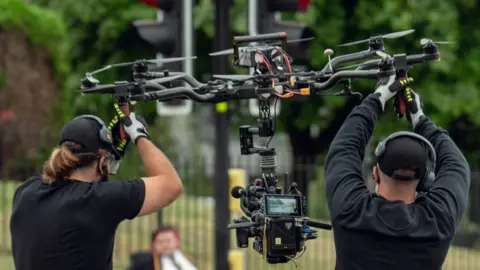### Revolutionary Camera Technology in “Adolescence”
In the realm of television and film, the technological advancements in camera equipment have dramatically altered storytelling capabilities. A prime example of this innovation is the Netflix series “Adolescence,” which has captivated over 120 million viewers in its first month. At the core of this creative success is cutting-edge camera technology allowing for groundbreaking filming techniques that were previously unimaginable.
The series opens with an intense scene where police raid a home. This intricate sequence unfolds entirely in one take, showcasing a chilling narrative of a young boy’s arrest. Such a feat, where the camera skillfully navigates through chaos and tension without cuts, is a direct result of advancements made in camera technology, especially the introduction of lightweight and versatile models like the DJI Ronin 4D.
### The Art of Filming in One Take
Matthew Lewis, the series’ cinematographer, explained that their approach involved shooting each approximately hour-long episode entirely in one continuous take, a method referred to as a “oner.” This technique allows the camera to dynamically follow characters through fast-paced scenes and swift transitions from different filming setups, such as handheld shots to those mounted on vehicles. The ability to fluidly switch between styles has transformed how filmmakers can visually narrate their stories.
The narratives presented in “Adolescence” demand not only advanced filming techniques but also the ability to adapt to rapidly changing environments. The DJI Ronin 4D camera, with multiple sensors to detect movement and environmental changes, plays a crucial role in achieving seamless transitions. These advancements provide filmmakers with tools to create a more engaging and immersive viewing experience.
### The Shift from Old to New Technology
The evolution of camera equipment has been significant over the past several years. Tim Palmer, a filmmaker and professor at Boston University, recounted his experiences with older technology that often hindered creative expression in previous projects. He illustrated this by referencing his work on the hospital drama “Critical” in 2014, where constraints in technology resulted in less dynamic camera movement. Considering how these older methods could only achieve robotic motions, the single-take approach in “Adolescence” represents a dramatic shift in capabilities.
Modern cameras such as the Ronin 4D have stabilizing features that allow operators to capture relatively steady shots even while on the move, whereas prior setups were limited by their cumbersome rigs and lack of fluidity. With the introduction of these lightweight and adaptable cameras, production quality is on the rise, leading to riveting storytelling in contemporary cinema and television.
### The Challenges of New Technology
While advancements such as the Ronin 4D provide filmmakers with significant capabilities, they also pose certain limitations, notably in formats commonly used for social media. Brett Halladay, product education manager at DJI, pointed out that while the camera excels in many areas, it doesn’t support vertical filming natively, which is increasingly desired due to the popularity of platforms like TikTok.
Canon’s EOS line, known for its lightweight construction, is another contender in the landscape of modern filmmaking. Barry Griffin, a manager at Canon, noted how these cameras are opening doors to new filmmaking possibilities, allowing creators to produce high-quality content in unconventional environments, like small studios or intimate settings.
### Balancing Technique and Storytelling
The growing fascination with filming in long takes—such as the ones featured in “Adolescence”—has ignited discussions regarding its potential as a storytelling gimmick versus a legitimate narrative technique. Carey Duffy of Cooke Optics cautioned that while the allure of one-take sequences is tantalizing, it’s essential to remember that compelling storytelling should not be sacrificed for technical flair.
Quote from Prof. Palmer emphasizes that while a unique filming approach can augment a project, it ultimately need not be the sole reason to engage viewers—a well-crafted story remains the foundation of successful visual media.
### Conclusion
The advancements in camera technology are propelling film and television into new dimensions, enabling filmmakers to convey complex narratives in visually dynamic ways. The use of towering techniques such as uninterrupted scenes in shows like “Adolescence” reflects the confluence of artistic vision and technical prowess that not only enhances storytelling but invites deeper viewer engagement. In this rapidly evolving field, the balance between technique and compelling narratives will shape the future of cinematic storytelling, ensuring that technology serves as a catalyst for creativity rather than a distraction from it.



